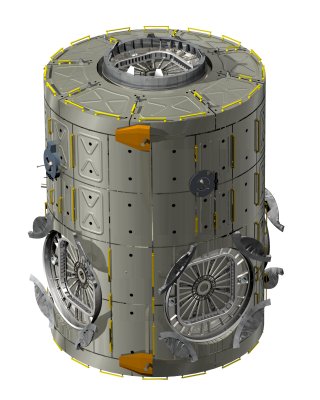Opis misji STS-130 (pierwotnie tekst ukazał się w internecie:
14.11.2009)
STS-130 (inne oznaczenie: ISS-20A) będzie 32 misją promu kosmicznego do Międzynarodowej Stacji Kosmicznej (ISS), 24 wyprawą wahadłowca
OV – 105 Endeavour i 130 lotem orbitalnym w dziejach programu
Space Shuttle. Zaplanowana na 12 dni (start: 4 luty 2010, lądowanie: 16 luty 2010) misja ma na celu dostarczenie trzeciego i tym samym ostatniego z ciśnieniowych modułów łącznikowych typu
Node, nazwanego
Tranquility (
Node 3) oraz obserwacyjnego
Cupola. Zaplanowane są trzy spacery kosmiczne.
STS-130 to także 161 załogowy lot kosmiczny NASA, 105 amerykańska załogowa misja od czasu katastrofy
Challangera, 17 od czasu katastrofy
Columbii, a także pierwsza z pięciu przewidzianych wstępnie na rok 2010, w którym ma zakończyć się eksploatacja promów STS.
LOGO http://spaceflight.nasa.gov/gallery/images/shuttle/sts-130/html/sts130-s-001.html
http://spaceflight.nasa.gov/gallery/images/shuttle/sts-130/html/sts130-s-001.htmlLogo misji zostało zaprojektowane przez załogę. Jego kształt i wypełnienie nawiązuje do wyposażonego w siedem okien modułu
Cupola. Na tym tle widoczne kontury wahadłowca z oznaczeniem misji, dookoła zaś nazwiska członków załogi. Na patchu widoczna jest także Ziemia i co ciekawe – za wzór posłużyła fotografia naszej planety wykonana 23 sierpnia 1966 przez krążącą wokół Księżyca amerykańską sondę
Lunar Orbiter 1. Jest to nawiązanie zarówno do historii, jak i przyszłości NASA – lotów na Księżyc.
ZAŁOGA http://en.wikipedia.org/wiki/File:STS-130_Crewphoto.jpg
http://en.wikipedia.org/wiki/File:STS-130_Crewphoto.jpgZałoga STS-130. Od lewej: Patrick, Virts, Behnken, Hire, Zamka i Robinson.
Składać się będzie z sześciu członków: dowódcy, drugiego pilota i czterech specjalistów misji. Tylko jedna z tych osób nie była wcześniej w Kosmosie:
1. George David Zamka, CDR http://spaceflight.nasa.gov/gallery/images/shuttle/sts-130/html/jsc2006e55043.html
http://spaceflight.nasa.gov/gallery/images/shuttle/sts-130/html/jsc2006e55043.htmlur. 29 czerwca 1962 w Jersey City, stan New Jersey
Pilot
US Marine Corps w stopniu pułkownika (3 500 godzin wylatanych na 30 typach samolotów, w tym 66 misji bojowych na
F/A-18 w ramach
Operacji Pustynna Burza)
Będzie to jego drugi lot w Kosmos. Jesienią 2007, jako drugi pilot brał udział w misji STS-120. Jest Amerykaninem o korzeniach rodzinnych wywodzących się z Kolumbii i Polski.
2. Terry Wayne Virts Jr, PLT http://spaceflight.nasa.gov/gallery/images/shuttle/sts-130/html/jsc2009e157219.html
http://spaceflight.nasa.gov/gallery/images/shuttle/sts-130/html/jsc2009e157219.htmlur. 1 grudnia 1967 w Baltimore, stan Maryland
Pilot
US Air Force w stopniu pułkownika (ponad 3 000 godzin na ponad 40 typach maszyn, służył m.in. w Niemczech, Korei Południowej, a także w Edwards AFB) STS-130 będzie jego kosmicznym debiutem.
3. Kathryn Patricia „Kay” Hire, MS http://spaceflight.nasa.gov/gallery/images/shuttle/sts-130/html/jsc2010e012250.html
http://spaceflight.nasa.gov/gallery/images/shuttle/sts-130/html/jsc2010e012250.htmlur. 26 sierpnia 1959 w Mobile, stan Alabama
Kapitan rezerwy
US Navy. Latała jako nawigator na samolotach patrolowych
P-3C Orion. Była członkiem sztabu w operacjach wojskowych
Enduring Freedom i
Iraqui Freedom.
Na orbitę uda się drugi raz. Jej debiut miał miejsce wiosną 1998 w misji STS-90.
4. Stephen Kern Robinson, MS http://spaceflight.nasa.gov/gallery/images/shuttle/sts-130/html/jsc2004e40089.html
http://spaceflight.nasa.gov/gallery/images/shuttle/sts-130/html/jsc2004e40089.htmlur. 26 października 1955 w Sacramento, stan Kalifornia
Doktor inżynierii mechanicznej (
Stanford University), weteran trzech misji kosmicznych: STS-85 (sierpień 1997), STS-95 (jesień 1998) i STS-114 (lato 2005) – ma na koncie trzy spacery kosmiczne w ostatniej z nich (pamiętny pierwszy z dwóch lotów
Return To Flight po katastrofie
Columbii)
5. Nicholas James MacDonald Patrick, MS/EV http://spaceflight.nasa.gov/gallery/images/shuttle/sts-130/html/jsc2006e49642.html
http://spaceflight.nasa.gov/gallery/images/shuttle/sts-130/html/jsc2006e49642.htmlur. 22 marca 1964 w Saltburn, Wielka Brytania
Jest inżynierem (
Massachusetts Institute of Technology), pracował w koncernie
Boeing.
W grudniu 2006 poleciał w Kosmos na pokładzie promu
Discovery (misja STS-116)
6. Robert Louis „Bob” Behnken, MS/EV http://spaceflight.nasa.gov/gallery/images/shuttle/sts-130/html/jsc2008e005285.html
http://spaceflight.nasa.gov/gallery/images/shuttle/sts-130/html/jsc2008e005285.htmlur. 28 lipca 1970 w Creve Coeur, stan Missouri
Podpułkownik, inżynier i pilot w
US Air Force (ponad 780 godzin wylatanych na przeszło 25 typach samolotów), pracował w Edwards AFB i brał udział w programie samolotu
F-22 Raptor.
Na orbitę leci po raz drugi. Wcześniej, w marcu 2008 brał udział w misji STS-123, w ramach którego trzykrotnie wychodził w otwartą przestrzeń.
ŁADUNEK:Tranquility (wcześniej Node 3) http://www.capcomespace.net/dossiers/ISS/europe/NODE/NODE.htm
http://www.capcomespace.net/dossiers/ISS/europe/NODE/NODE.htm http://www.popsci.com/military-aviation-amp-space/article/2009-03/stephen-colbert-nasa-and-so-can-you
http://www.popsci.com/military-aviation-amp-space/article/2009-03/stephen-colbert-nasa-and-so-can-youJego nazwa nawiązuje do lądowania
Apollo 11 na księżycowym Morzu Spokoju (
Mare Tranquilitatis) w lipcu 1969 roku. W ten sposób, 40 lat później NASA zamierzała oddać hołd owemu bezprecedensowemu wydarzeniu. Jest to ostatni z trzech modułów ciśnieniowych
Node. Poprzednie:
Node 1 (
Unity) i
Node 2 (
Harmony) są już zintegrowane z Międzynarodową Stacją Kosmiczną. Zbudowany został w Turynie dla NASA przez kompanię
Thales Alenia Spacepod okiem Europejskiej Agencji Kosmicznej (ESA) i Włoskiej Agencji Kosmicznej. Pierwotnie miał on służyć stricte jako element łącznikowy (tak jak pozostałe
Node posiada sześć portów CBM –
Common Berthing Mechanism), aktualnie – ma przejąć część obowiązków skasowanego modułu
Transhab: w tym najbardziej zaawansowany, jak dotąd, system podtrzymywania życia, jaki znajdzie się w Kosmosie (odzyskiwanie wody i powietrza dla załogi ISS). Ponadto ma zawierać ruchoma bieżnię do ćwiczeń dla astronautów, tzw.
Waste and Hygiene Compartment (czyli... toaleta), a także chłodziarko-zamrażarkę, kuchnię, magazyn, zbiorniki na wodę i pomieszczenie na żywność, lekarstwa i odzież załogi. Średnica konstrukcji: 4,5 m, długość: 6,7 m.
Po przetransportowaniu modułu na orbitę w ładowni wahadłowca
Endeavour, ma on zostać przyłączony do innego
Node,
Unity w porcie przeciwległym do modułu
Quest. Z kolei do nadir portu
Tranquility dołączona ma zostać
Cupola.
Aktualnie oba elementy znajdują się na Florydzie, gdzie przybyły 20 maja 2009. Oficjalny odbiór przez KSC nastąpił 8 czerwca.
Cupola http://www.nasa.gov/centers/kennedy/stationpayloads/cupola.htmlCupola
http://www.nasa.gov/centers/kennedy/stationpayloads/cupola.htmlCupola, czyli Kopuła jest modułem zbudowanym przez ESA rękoma
Thales Alenia Space. Jest to niewielka konstrukcja wyposażona w siedem pancernych okien (sześć trapezoidalnych po bokach i jedno okrągłe, centralnie) Ma ona pełnić funkcje obserwacyjne (Ziemia, Księżyc i inne ciała niebieskie), umożliwić podgląd o 360 stopni i być jednym ze stanowisk dla operatora ramienia
Canadarm 2.
Cupola ma ok. 2 m średnicy i 1,5 m wysokości.
ŹRÓDŁA:- oficjalna strona NASA
- strona Loty Kosmiczne
- Wikipedia